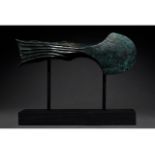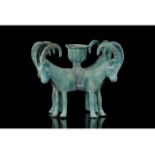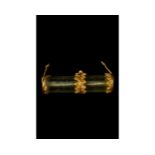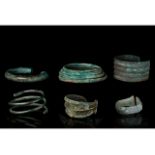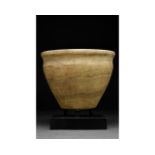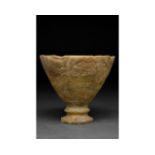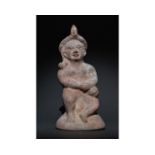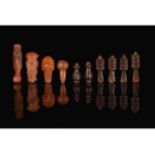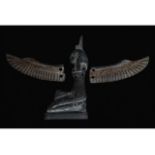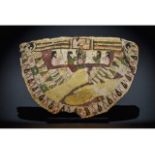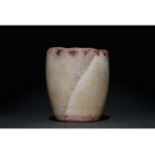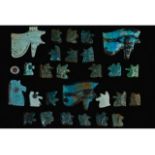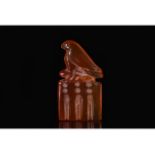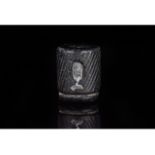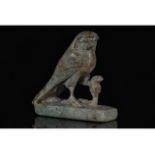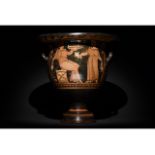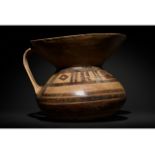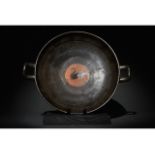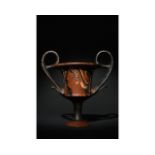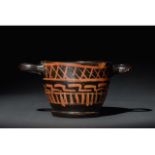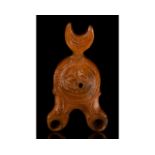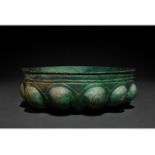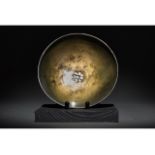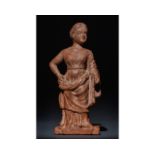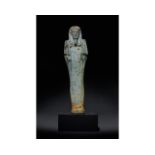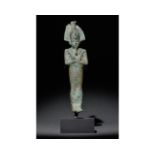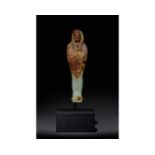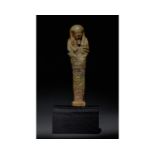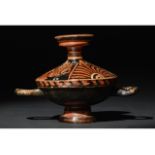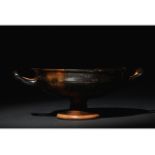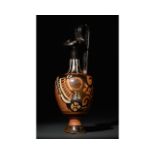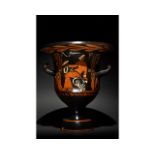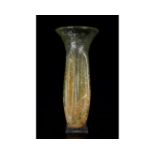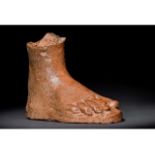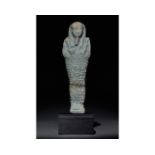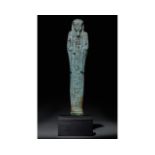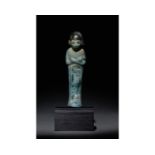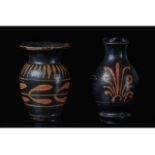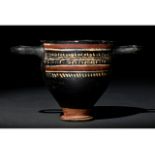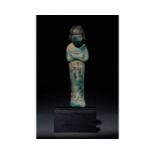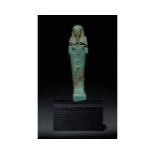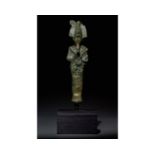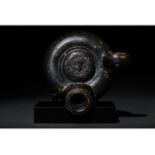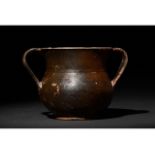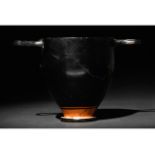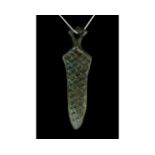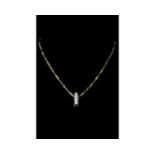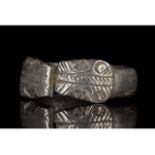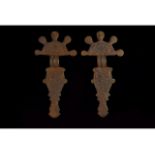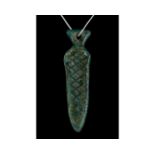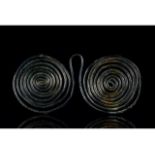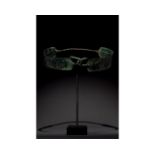Filtered by:
- Category
- List
- Grid
A subscription to the Price Guide is required to view results for auctions ten days or older. Click here for more information
Ca. 900-700 BC. Koban-Caucasian Culture. A very rare bronze axe, richly decorated with geometric ornaments on the crescentic blade and a range of ...
Ca. 900-700 BC. Koban-Caucasian Culture. A beautiful incense burner in the shape of four rams. The animals, standing on their front legs, are faci...
Ca. 600-400 BC. Scythian. A beautiful gold and rock crystal amulet in the shape of a tube with ribbed gold ends and a ribbed central section; atta...
Ca. 800-600 BC. Bronze Age. Europe. A collection of bronze bracelets, each with an attractive green patina. Each bracelet is made of a single rod ...
BACTRIAN ALABASTER VESSEL
Ca. 3100-2500 BC. Bactrian. A fine Bactrian alabaster vessel, featuring a flat foot, a slightly bulbous body with the sides slightly flaring outwa...
BACTRIAN ALABASTER VESSEL
Ca. 3100-2500 BC. Bactrian. A fine conical Bactrian alabaster vessel, standing on a narrow flared foot. It has a beautiful cream colour, with grey...
Ca. 100-200 AD. Roman Period. A terracotta figure of the young god Harpocrates, covered with traces of white pigment. He is represented nude, infa...
Ca. 1520-30 BC. New Kingdom – Ptolemaic Dynasty. A collection of ten amulets. Four of them are made of orange-red carnelian, and the other six a...
EGYPTIAN INLAY OF ISIS
Ca. 664-30 BC. Late Period - Ptolemaic Dynasty or later. A black inlay of the goddess Isis. She is depicted in profile, kneeling on a plinth with ...
Ca. 323 BC-300 AD. Graeco-Roman Period. A wesekh ('broad') collar made of cartonnage, a plastered material, to be worn by a mummy. The collar is s...
EGYPTIAN ALABASTER CUP
Ca. 2055-1077 BC. Middle Kingdom - New Kingdom. A small cup of Egyptian alabaster. It has a flat base and a round body which rises almost straight...
EGYPTIAN 28 EYE AMULETS
Ca. 664-30 BC. Third Intermediate Period to Late Period. A group of 28 amulets depicting eyes, mostly in the typical fashion of the Eye of Horus. ...
EGYPTIAN SEREKH AMULET
Ca. 1550-1077 BC. New Kingdom. A carnelian amulet in the shape of a serekh. A perched falcon of Horus sits on top of a schematic façade of a palac...
EGYPTIAN BLACK CARTOUCHE BEAD
Ca. 1550-1077 BC. New Kingdom. A black-glazed faience bead. The bead is cylindrical, with a suspension hole running through it. The exterior is de...
Ca. 323 BC-200 AD. Graeco-Roman Period. A green stone statuette of a falcon catching a snake. The falcon stands on a long and thick plinth with it...
Ca. 400-300 BC. Apulian. This beautiful red-figure bell terracotta krater with everted rim features a pedestal foot, a cylindrical stem, a bell-sh...
Ca. 400-300 BC. Daunian. A large pottery krater with a globular body, funnel-shaped neck, and a strap handle. The body is decorated with a series ...
Ca. 520-450 BC. Greek Attic. A beautiful black-figure Attic kylix, i.e. a wide-bowled drinking cup with a large, black glazed low foot and twin ho...
Ca. 350-300 BC. Apulian. A rare red-figure kantharos. This tall stemmed cup has two sweeping high handles and a gently flared body that sits on a ...
GREEK APULIAN XENON WARE SKYPHOS
Ca. 400-300 BC. Apulian. An ancient Apulian xenon-ware skyphos, i.e. a deep wine cup with a low flanged base and dual-handle below a slightly thic...
Ca. 400-500 AD. Late Roman. A large terracotta, twin flame oil lamp with two voluted round-tipped nozzles and a crescent moon-shaped handle with a...
Ca. 500-330 BC. Central Asian/ Mediterranean. A beautiful hammered bronze phiale (libation dish). The exterior surface is decorated with eleven eg...
Ca. 500-330 BC. Graeco/Achaemenid. A bronze libation bowl known as 'phiale' decorated with a central rosette. Phialai were wide shallow cups used ...
Ca. 100-300 AD. Roman. A beautifully preserved, hammered silver vessel with a plain rim and an interior surface decorated with an incised ring of ...
Ca. 200 AD. Middle-Imperial Roman. A beautifully preserved female terracotta figure standing with her weight on her right leg, her left bent forwa...
Ca. 664-332 BC. Late Period. A pale blue-glazed faience shabti on a modern stand. The head wears a striated lappet wig and a false beard, with exq...
Ca. 664-30 BC. Late Period - Ptolemaic Dynasty. A bronze statuette of Osiris on a modern stand. He wears an atef crown, plumed on each side with o...
Ca. 664-332 BC. Late Period. A pale blue-glazed faience shabti on a modern stand, with a reddish-brown colouring over the upper half of the front....
EGYPTIAN FAIENCE SHABTI
Ca. 664-332 BC. Late Period. A glazed faience shabti. The head wears a lappet wig and a false beard, with detailed facial features modelled on the...
Ca. 400-300 BC. Apulian. A beautiful terracotta lekanis with a broad low foot, dome-shaped lid and ribbon-shaped handles. The lid is divided into ...
APULIAN BLACK GLAZED KYLIX
Ca. 400-300 BC. Apulian. A nice Apulian kylix with a strong metallic glaze. The broad, relatively shallow, body rests on a broad foot with central...
Ca. 400-300 BC. Apulian. A beautiful terracotta oinochoe (wine jug) with a round conical foot with fillet, trefoil lip, and upturned handle. The b...
Ca. 400-300 BC. Apulian. This beautiful terracotta bell krater features a pedestal foot, cylindrical flared stem, inverted bell-shaped body, two u...
ROMAN GLASS BOTTLE
Ca. 100-300 AD. Roman. A beautiful glass bottle with a long, cylindrical body displaying six vertical grooves, a short, flared neck and a wide eve...
ETRUSCAN TERRACOTTA FOOT
Ca. 300 BC. Etruscan. A moulded, naturalistically modelled, votive terracotta foot with delineated toenails set on a high sole. The practice of cr...
EGYPTIAN FAIENCE SHABTI
Ca. 664-332 BC. Late Period. A pale blue-glazed faience shabti on a modern stand. The head wears a lappet wig and a false beard, with detailed fac...
EGYPTIAN FAIENCE SHABTI
Ca. 664-332 BC. Late Period. A pale blue-glazed faience shabti on a modern stand. The head wears a lappet wig and a false beard, with detailed fac...
Ca. 1069-720 BC. Third Intermediate Period. A blue-glazed faience shabti of the priest Pa-Di-Khonsu on a modern stand. A short, black-glazed wig r...
Ca. 400-300 BC. Apulia. A beautiful pair of miniature South Italic xenon ware vessels. One is a classic olpe with an elegant body featuring two de...
GREEK GNATHIAN SKYPHOS
Ca. 400-300 BC. Apulian. An elegant Gnathian ware skyphos (drinking cup) with a rounded body on a low flanged ring base and ear-shaped horizontal ...
Ca. 400-300 BC. Apulian. A black-glazed terracotta guttos (oil-lamp filler) with a spool-shaped foot, a wheel-shaped body, a protruding ring handl...
Ca. 1069-720 BC. Third Intermediate Period. A blue-glazed faience shabti of the priest Pa-Di-Khonsu on a modern stand. A short, black-glazed wig r...
EGYPTIAN INSCRIBED SHABTI
Ca. 664-332 BC. Late Period. A pale blue-glazed faience shabti on a modern stand. The head wears a lappet wig and a false beard, with detailed fac...
EGYPTIAN BRONZE VOTIVE OSIRIS
Ca. 664-30 BC. Late Period - Ptolemaic Dynasty. A bronze statuette of Osiris on a modern stand. He wears an atef crown, plumed on each side with o...
Ca. 400-300 BC. Apulian. A black-glazed terracotta guttos (oil-lamp filler) with a spool-shaped foot, a wheel-shaped body, a protruding ring handl...
GREEK APULIAN POTTERY KANTHAROS
Ca. 400-300 BC. Apulian. A terracotta kantharos with a ring foot, carinated body, flaring neck, and two high strap handles. The dark slip that use...
Ca. 400-300 BC. Apulian. An elegant black glazed terracotta skyphos (drinking cup) with a rounded body on a ring base; just below the lip, two ear...
BRONZE AGE SWORD SHAPED PENDANT
Ca. 600 BC. Koban culture. A beautiful bronze sword-shaped pendant with interlaced decoration; circular loop in the sword's hilt; fully wearable c...
Ca. 664-30 BC. Late Period - Ptolemaic Dynasty. A necklace made of restrung glazed beads with a faience amulet of the goddess Taweret. The beads a...
Ca. 100-300 AD. Roman. A beautiful silver ring of penannular form featuring a circular band that terminates in two highly stylised snake-heads. Go...
Ca. 400-600 AD. Visigothic. Two radiate-headed bow brooches, each with D-shaped headplate and five applied radiating balustered knops (four knobs ...
BRONZE AGE SWORD SHAPED PENDANT
Ca. 600 BC. Koban culture. A beautiful bronze sword-shaped pendant with interlaced decoration; circular loop in the sword's hilt; fully wearable c...
BRONZE AGE SPECTACLE PENDANT
Ca. 800-600 BC. Bronze Age. Europe. A beautiful Celtic bronze pendant formed as an omega-shaped plaque of round-section wire with coiled ends. Goo...
INTACT BRONZE AGE BELT
Ca. 1000-650 AD. Western Asiatic. A very rare, intact bronze belt made of two wide lateral bronze rectangular bands embellished with linear decora...

